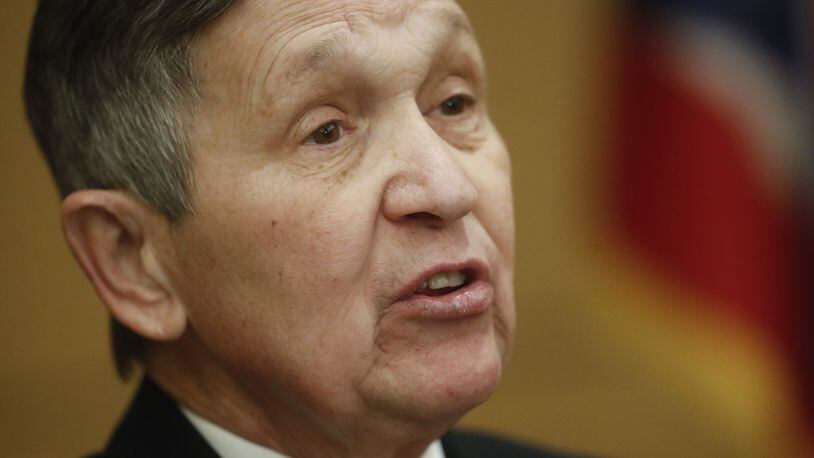RELATED: Kucinich among the candidates for governor to debate in Middletown on April 10
Kucinich, a former Cleveland mayor and congressman, still living in the same house he bought in 1971, is pushing for affordable health care, a ban on assault rifles and fracking, and free college tuition.
He also said he is “energizing millennials,” and was endorsed in February by the of Sanders-backed Our Revolution and recently endorsed by Hamilton County Commissioner Todd Portune.
“We are energizing younger people, and we’re also reaching out to those Democrats who feel the party doesn’t represent them, or the party’s let them down,” Kucinich said in an exclusive interview with the Journal-News.
But Kucinich, a Fox News contributor, has also agreed with President Donald Trump on many of issues, from trade to calling the Russia investigation a hoax.
And while as a congressman from Northern Ohio, he worked with former House Speaker John Boehner and was the only Democrat to support Rob Portman’s appointment to trade secretary in 2005.
GET YOUR TICKETS: Reserve your free ticket for the Ohio gubernatorial debate among 4 Democratic candidates — before they run out
“I was the only Democrat to step up to say, ‘He’s a good guy,’ Other Democrats were trying to block him,” he said. “I will work with everyone. I may have a different way of approaching things, and I do, but I try to build relationships to get things done. And because I took that approach, I’ve gotten along very well with Republicans. But no one will mistake me for a Republican.”
Kucinich is one of six candidates seeking the Ohio Democratic Party's nomination for governor in the May 8 primary. Kucinich is running against former Ohio Attorney General and federal consumer financial watchdog Richard Cordray, Ohio Sen. Joe Schiavoni and former Ohio Supreme Court Justice Bill O'Neill. Paul Ray, of Alliance, a political newcomer, and Larry Ealy, of Dayton, a former stripper, are also on the ballot.
But the race, according to the last two published polls, is seemingly between the last two candidates to enter: Kucinich and Cordray.
SurveyUSA’s poll conducted from March 16-20 shows Kucinich and Cordray in a statistical tie at 21 percent each with 46 percent of respondents undecided. Kucinich appeared to have gained ground on Cordray, who according to a Fallon Research poll in mid-January was leading the field with 23 percent to Kucinich’s 16 percent.
Kucinich entered the race in in January. And he did so because he “thought the field really needed a voice for the people of Ohio who are concerned about jobs, about moving the state’s economy forward, about clean water and air, about farming.”
He also entered the race because he felt the Democratic Party needed a bit of energy and said the Democratic Party had failed its members and constituents — more at the national level, though. But he said the state party has failed to distinguish itself from the Republican Party "which has resulted in Democrats not being able to win statewide."
“Also, there’s a lack vitality, of energy and the feeling of candidates who are flatlining,” Kucinich said. “The people are looking for an energetic approach. They’re looking for someone looking to shake up the status quo, which the party has been lethargic.”
Ohio Democratic Party Chairman David Pepper said there hadn’t been any lethargy or lack of energy among the party since he became chair after the 2014 gubernatorial election.
“We have been working really hard to create the next generation of candidates,” he said.
Since Pepper took over as the Ohio Democratic Party’s chair in December 2014, “Despite the terrible outcome of ‘16, the thing the state party has done very well is work to build a bench of candidates all over Ohio.”
That includes having a Democrat running against every open Statehouse seat for November’s election — which includes the 99 House seats and 17 open Senate seats.
“One thing I think he’ll learn as he goes across the state is because the last couple years we’ve been building a bench of candidates by focusing … at the grassroots level,” Pepper said. “There’s actually a great vitality right now when it comes to getting good candidates, and that all starts at the local level. It doesn’t start for running for governor. It starts with having good people running for city council, and mayor and county commission.”
Pepper said the party “couldn’t be more different” than it was in the 2014 statewide election and believes the party’s new “vitality” will help the Democratic Party’s candidate win in November because “there so many great candidates running down-ticket which will help generate enthusiasm.”
Kucinich said he believes he can win in May, and eventually in November against either Ohio Lt. Gov. Mary Taylor or Ohio Attorney General Mike DeWine is because his ticket — which includes Cleveland City Councilmember Tara Samples as his lieutenant governor — “will mobilize and excite people to participate” and instills a feeling “of a new Ohio.”
“There’s a new Ohio about to be born through this campaign,” he said. “And it’s one that is inclusive politically and in every other way. I think people are waiting for that. I think there’s a sense of excitement of possibilities about the state, about the creative potential of government.”
About the Author
